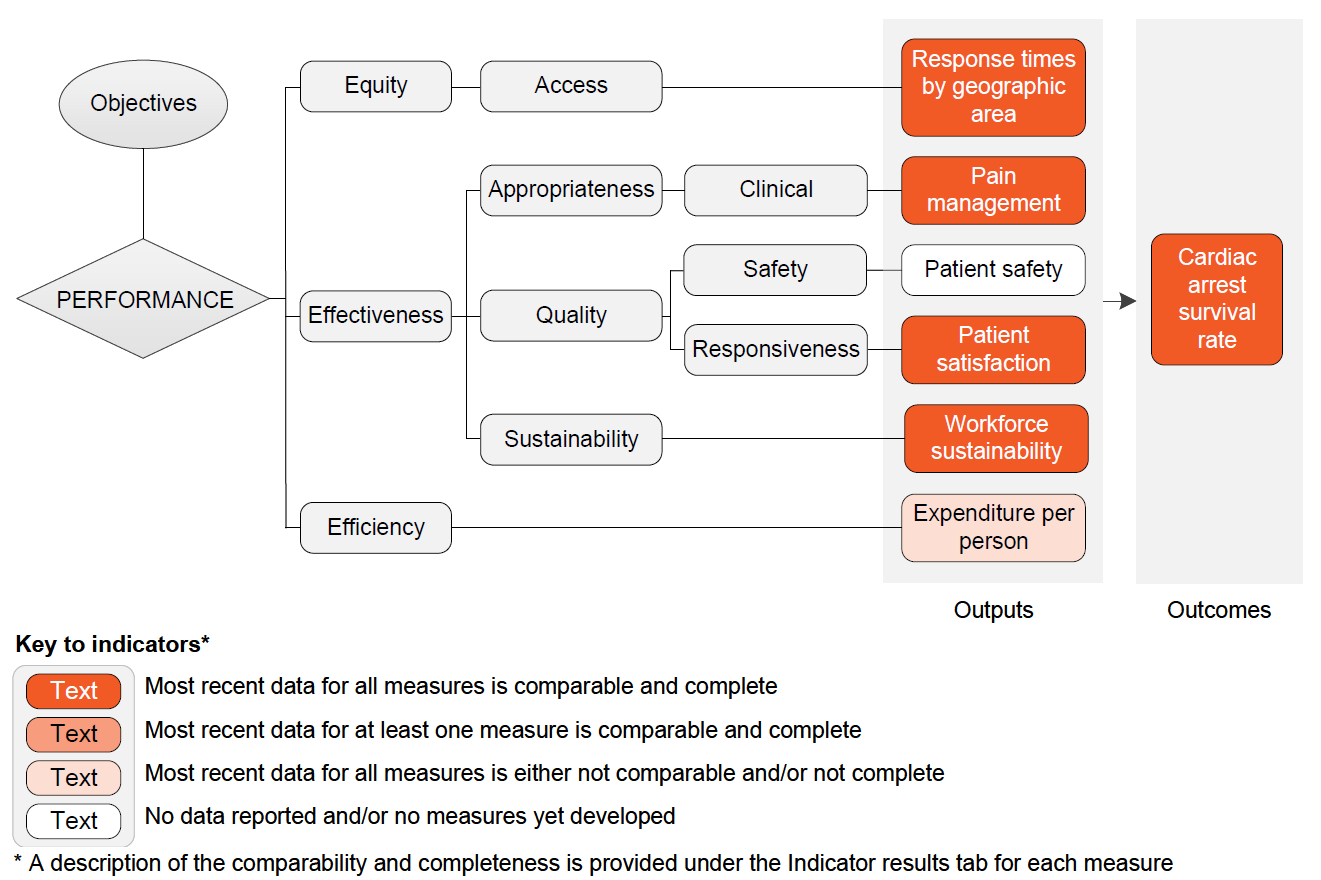WORKING GROUP DRAFT – IN CONFIDENCEReport on Government Services 2026
PART E, SECTION 11: RELEASED ON 5 FEBRUARY 2026
11 Ambulance services
This section reports on the performance of ambulance service organisations, which are the primary agencies involved in providing emergency medical care, pre-hospital and out-of-hospital care, and transport services.
The Indicator results tab uses data from the data tables to provide information on the performance for each indicator in the Indicator framework. The same data in the data tables is also available in CSV format.
Data downloads
Refer to the corresponding table number in the data tables for detailed definitions, caveats, footnotes and data source(s).
Objectives for ambulance services
Ambulance services aim to promote health and reduce the adverse effects of emergency events on the community by providing emergency medical care, pre-hospital and out-of-hospital care, and transport services that are:
- accessible and timely
- meet patients' needs through delivery of appropriate health care
- high quality – safe, co-ordinated and responsive health care
- sustainable.
Governments aim for ambulance services to meet these objectives in an equitable and efficient manner.
Ambulance services comprise:
- emergency and non-emergency pre-hospital and out-of-hospital patient care and transport
- inter-hospital patient transport including the movement of critical patients
- specialised rescue services
- responding to multi-casualty events
- community capacity building to respond to emergencies (for example, cardiopulmonary resuscitation (CPR) and first aid training).
Ambulance service organisations are the primary agencies involved in providing services for ambulance events. State and territory governments provide ambulance services in most jurisdictions. In Western Australia and the Northern Territory, St John Ambulance is contracted by government to be the primary provider of ambulance services.
Across jurisdictions, ambulance service organisations are an integral part of the health system. The role of paramedics has expanded over the past decade to include assessment and management of patients with minor illnesses and injuries to avoid hospitalisation.
In 2023-24, total ambulance service organisation revenue was $5.6 billion, a decrease of 1.7% from 2022-23 and representing an average annual growth rate over the past five years of 5.0% (table 11.1).
Jurisdictions have different funding models to resource ambulance service organisations. Nationally in 2023-24, state and territory government grants and indirect government funding formed the greatest source of ambulance service organisation funding (79.7%), followed by transport fees (from public hospitals, private citizens and insurance) (15.8%), and subscriptions and other income (4.6%) (table 11A.1).
Human resources
Nationally in 2023-24, for ambulance services reported in this section there were:
- 24,145 full time equivalent salaried personnel (81.9% were ambulance operatives)
- 6,275 volunteer personnel (88.5% were ambulance operatives)
- 955 paramedic community first responders. Community first responders are trained volunteers that provide an emergency response (with no transport capacity) and first aid care before ambulance arrival (table 11A.2).
Registered paramedics
Paramedics must be registered with the Paramedicine Board of Australia and meet the Board’s registration standards to practise in Australia (Australian Health Practitioner Regulation Agency (AHPRA) Paramedicine Board of Australia, 2024).
In 2023-24, there were 25,345 registered paramedics in Australia (including 708 non‑practising registered paramedics) (table 11A.3).
‘Qualified ambulance officers’ must be registered paramedics (table 11A.2). It is possible some registered paramedics are employed by an ambulance service to work in a different role, such as other clinical or communication roles. Some registered paramedics work in other (non-ambulance) organisations.
Demand for ambulance services
Nationally in 2023-24, there were:
- 4.4 million incidents (events that resulted in demand for ambulance services) reported to ambulance service organisations (164.8 incidents per 1,000 people)
- 5.8 million responses where an ambulance was sent to an incident (216.0 responses per 1,000 people). There can be multiple responses sent to an incident. There can also be responses to incidents where people do not require treatment and/or transport
- 4.2 million patients assessed, treated or transported by ambulance service organisations (156.1 patients per 1,000 people) (figure 11.1).
Ambulance service organisations prioritise incidents as:
- emergency – immediate response required under lights and sirens (code 1)
- urgent – undelayed response required without lights and sirens (code 2)
- non-emergency – non-urgent response required (codes 3, 4)
- casualty room attendance.
Nationally in 2023-24, 43.3% of the 4.4 million incidents reported to ambulance service organisations were prioritised as emergency incidents, followed by 31.6% prioritised as urgent and 25.0% prioritised as non-emergency (table 11A.4).






